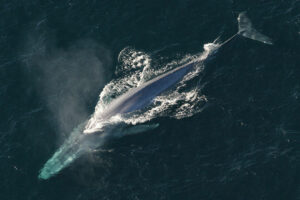
Blue whales found to swallow 10 million microplastic pieces daily
WASHINGTON — As Earth’s largest animals, blue whales are mighty big eaters, gulping tons of food each day. They also now are ingesting huge amounts of plastic, according to scientists, due to the alarming volume of tiny particles of pollution choking the oceans.
Researchers on Tuesday presented an estimate of the amount of microplastics ingested by three species of baleen whales — blue, fin and humpback — off the US Pacific coast, detailing an issue posing uncertain health concerns for these marine mammals.
As baleen whales, these species are filter-feeders. They strain food — shrimp-like crustaceans called krill and other small prey — from the seawater using baleen plates in the mouth made of keratin, the substance found in people’s fingernails.
Blue whales, according to the study, may swallow roughly 10 million microplastic pieces daily, or up to about 95 pounds (43.5 kg) of plastic. For fin whales, whose main prey also is krill, the estimated daily tally is about 6 million microplastic pieces, or up to 57 pounds of plastic.
Some humpback whales specialize in krill and some favor eating small schooling fish. Krill-favoring humpbacks, according to the study, may ingest about 4 million microplastic pieces (up to 38 pounds of plastic) daily, while those favoring fish may take in a much smaller amount, roughly 200,000 pieces (up to a couple of pounds of plastic).
“In the moderately polluted waters off the US West Coast, baleen whales may still be ingesting millions of microplastics and microfibers per day,” said Stanford University marine biologist Matthew Savoca, a co-author of the study published in the journal Nature Communications.
“Also we find that the vast majority — 99% — are via their prey that have previously ingested plastic and not from the water they filter,” Mr. Savoca added.
The study illustrated how baleen whales may be at an elevated risk for microplastics ingestion as a result of their mode of feeding, the quantity of their food intake, and their habitat overlapping with polluted areas such as the California Current that flows south along North America’s western coast.
Blue whales can reach a maximum of about 100 feet (30 meters) long, fin whales about 80 feet (24 meters) and humpback whales about 50 feet (15 meters).
The researchers estimated the daily microplastic ingestion by examining the foraging behavior of 126 blue whales, 65 humpback whales and 29 fin whales using measurements from electronic tag devices suction-cupped to the animal’s back, with a camera, microphone, GPS locator and an instrument that tracks movement. They then factored in the concentrations of microplastics in the California Current.
As a study published last year based on the same whales off the U.S. West Coast showed, blue whales eat about 10–20 tons of krill daily, while fin whales eat 6–12 tons of krill and humpback whales eat 5-10 tons of krill or 2–3 tons of fish.
The new study found that the whales primarily feed at depths of 165–820 feet (50–250 meters), coinciding with the highest measured microplastic concentrations in the open-ocean ecosystem.
Microplastics are particles of plastic debris — less than 5 mm (0.2 inch) long — arising from the disposal and breakdown of various consumer products and industrial waste, with their concentrations in the oceans mounting in recent decades. The potential health effects on the whales from ingesting it is not well understood.
“While this was not the focus of our study, other research has shown that if plastics are small enough they can cross the gut wall and get into internal organs, though the long-term effects are still unclear. Plastics can also release chemicals that are endocrine disruptors,” said marine biologist Shirel Kahane-Rapport of California State University, Fullerton, lead author of the study. — Reuters
